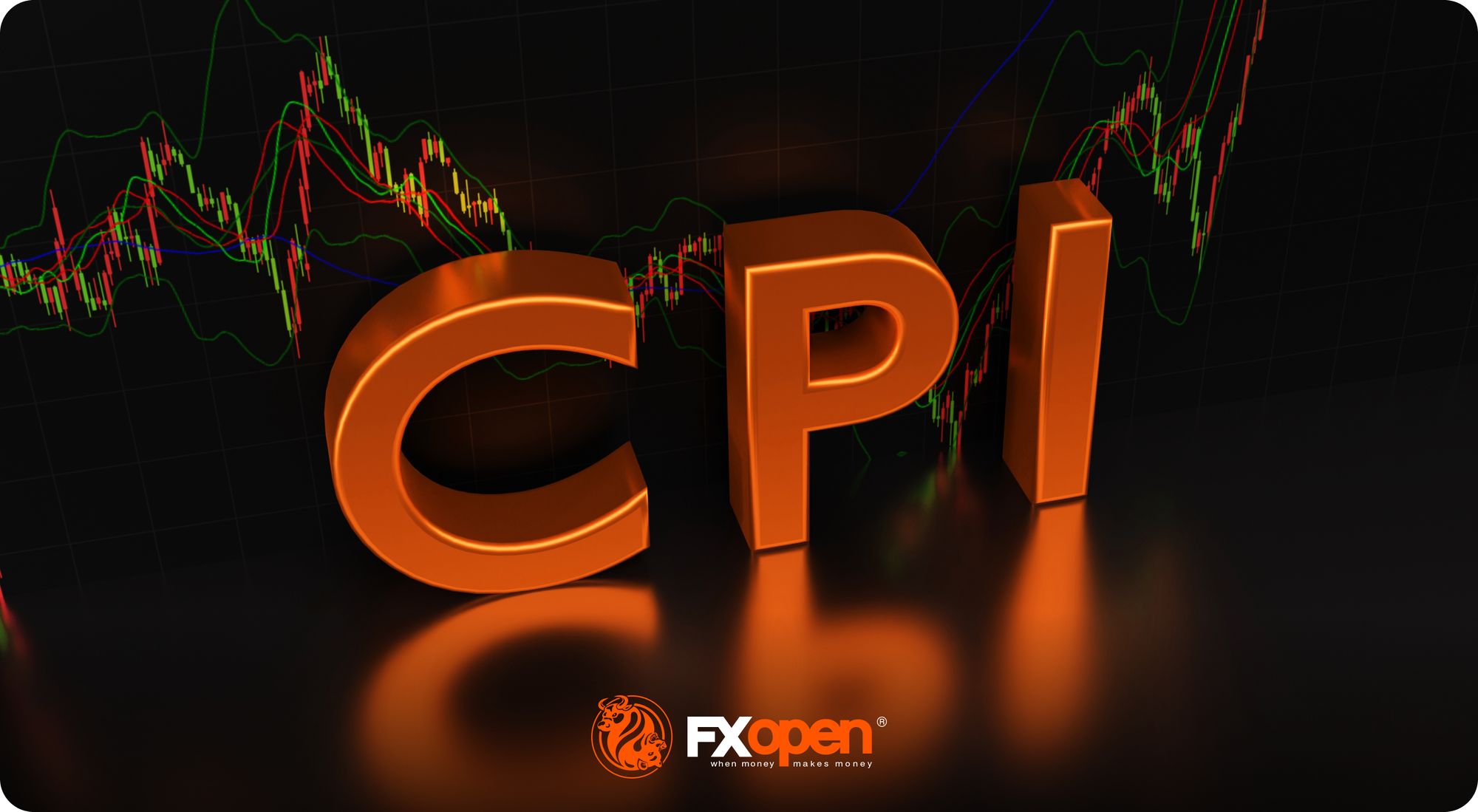FXOpen

The Consumer Price Index (CPI) report is a vital economic indicator that measures inflation by tracking changes in the prices of goods and services. Understanding CPI data is crucial for traders as it influences interest rates, market trends, and investment strategies. This article delves into the intricacies of the CPI report, explaining its significance and how traders can utilise it in their trading decisions.
Understanding the CPI
Understanding the CPI is crucial for grasping inflation trends and their broader economic implications. The CPI measures the average price change over time, generally a year, quarter, or a month, for a basket of goods and services typically purchased by households.
In the US, the Bureau of Labor Statistics (BLS) collects price data on a wide range of items, including food and beverages, housing, apparel, transportation, medical care, recreation, education and communication, and other goods and services. This data is then weighted based on consumer spending patterns to calculate the Consumer Price Index.
In the UK, the Office for National Statistics (ONS) publishes the CPI, similar to the US model, while the European Union releases both individual country CPIs and a harmonised index for the Eurozone. Australia's CPI is released by the Australian Bureau of Statistics (ABS).
There are two main types of CPI:
- Headline CPI: This is the most comprehensive measure, including all items in the consumer basket. It captures overall inflation but can be volatile due to fluctuating food and energy prices.
- Core CPI: This excludes food and energy prices, which are highly volatile. Core CPI provides a clearer view of underlying inflation trends, helping policymakers and traders focus on sustained price changes.
Headline CPI is considered the most important, closely followed by Core CPI. Traders focus on year-over-year (YoY) and month-over-month (MoM) rates, with the YoY headline and core rates receiving the most attention due to their longer-term view of inflation. The YoY rate compares the current CPI with the same month in the previous year, providing a long-term view of inflation trends. The MoM rate compares the current CPI with the previous month, offering a shorter-term perspective. Traders look to these rates to gauge how fast or slow inflation is growing.
CPI and Inflation Rate
CPI is a specific measure of the price level of a fixed basket of goods and services. It provides a snapshot of the cost of a fixed basket of goods and services at a given point in time and is expressed as an integer (e.g. May’s US CPI reads 314.07).
Inflation Rate
The inflation rate is a percentage change that indicates how much the general price level is rising over time.
In essence, the CPI provides the data needed to calculate the inflation rate, which in turn gives insight into the economic trend of rising prices.
CPI data is critical for policymakers, businesses, and traders. Policymakers use it to adjust economic policies and social security benefits. Businesses use CPI trends to set prices and wages. Understanding the CPI report helps traders gauge inflationary pressures, anticipate monetary policy actions, and adjust their trading strategies accordingly.
Schedule of Releases for the Consumer Price Index
The schedule of Consumer Price Index releases varies across major economies. Below is the CPI release time for the most notable economies:
- United States: Monthly, usually around the middle of the month, released by the Bureau of Labor Statistics (BLS).
- United Kingdom: Monthly, typically around the middle of the month, published by the Office for National Statistics (ONS).
- Eurozone: Monthly, with preliminary data at the end of the month and final data in the middle of the following month, released by Eurostat.
- Individual Eurozone Countries: Monthly, with slight variations; national statistics agencies release individual country data.
- Australia: Quarterly, released by the Australian Bureau of Statistics (ABS).
- Japan: Monthly, typically at the end of the month, published by the Statistics Bureau.
- Canada: Monthly, around the third week of the month, released by Statistics Canada.
CPI Meaning in Forex and Other Markets
Interpreting CPI data is essential for traders aiming to understand inflation trends and their potential market impacts. CPI data helps central banks, like the Federal Reserve in the US, the Bank of England, and the European Central Bank, monitor inflation and adjust monetary policy. Central banks often have a target inflation rate as a sign of a healthy economy. This target informs decisions on interest rates and other monetary policies. In a high CPI environment, where inflation is consistently above the target, central banks may raise interest rates to cool the economy. Conversely, in a low CPI environment, they may lower rates to stimulate spending and investment.
Short-term Implications
In the short term, traders compare actual CPI results with forecasts or consensus estimates, which are available through FXOpen's economic calendar or financial news sites like Bloomberg and CNBC. Whether CPI is higher or lower than the previous month tends to have less bearing for short-term traders.
A weaker-than-expected result, indicating lower inflation, typically weakens a currency and boosts stocks. This is because it suggests future monetary policy will be looser, either through lower interest rates or maintaining current low rates.
Conversely, a higher-than-expected result suggests rising inflation, likely leading to a stronger currency and weaker stock market due to anticipated tighter monetary policy.
If the CPI meets the forecast, the market reaction is usually weak as the data is priced in. However, the currency is expected to rise/fall before the release. For example, if the CPI is expected to be higher, this could strengthen the currency and weaken stocks ahead of the release.
Long-term Implications
Over the long term, the trend in CPI data is more critical. Policymakers typically look for sustained movements in the inflation rate before making significant monetary policy changes. For example, a higher-than-forecast CPI rate might strengthen a currency in the short term, but if it occurs within a longer-term trend of falling inflation, it may not lead to immediate interest rate hikes and the currency is likely to weaken over time, all else being equal.
Additional Considerations
Traders also consider the broader economic context, such as employment data and GDP growth, when interpreting CPI data. For instance, if the labour market is strong (low unemployment) and GDP growth is robust, then a high inflation reading may result in a significant strengthening of a currency since the economy appears to be overheating and may require higher interest rates.
However, as described, the market expectation is generally the most important when trading CPI news. If the market is already expecting a high inflation reading in this scenario, then a weaker-than-forecast CPI report may actually weaken a currency initially, even if inflation remains elevated overall.
Trading the CPI Report
Here are the main steps traders follow when trading CPI reports.
Preparing for the Report
Before the release of the CPI report, it’s crucial to gather insights and projections from analysts. Researching consensus ranges by searching terms like "US CPI May 2024 consensus ranges" can also help traders understand potential deviations from the expected figures, which is useful for understanding what constitutes an expectation vs a surprise.
It’s worth noting that, in periods of low inflation, CPI tends to be more stable and predictable. However, during high or volatile inflation, the market reaction can be more pronounced.
Traders can also monitor leading inflation indicators such as the Producer Price Index (PPI). This indicator reflects the inflationary pressures faced by producers, which can influence the CPI. While these should be used holistically rather than as definitive signals, they can provide valuable context for anticipating CPI movements.
Trading Before the Report
The CPI release is typically one of the most volatile events of the month for stocks and currencies, especially during periods of heightened inflation focus, as seen since 2021. Traders either position themselves based on their expectations or wait for the release to act.
Those taking positions before the release do so several hours before the release to catch the increased volatility, but they close their trades just before the data is out to avoid potential losses due to unexpected market reactions.
Post-Release
Following the release, there are usually two main outcomes: a trend triggered by a surprise or a reversal.
Surprise Outcome
A significant deviation from expectations (higher or lower) can lead to a repricing of assets, resulting in increased market volatility and a change in the price movement. In such scenarios, some traders wait for a pullback as traders take profits. These pullbacks can potentially provide good entry points as long as the underlying data is in line with the trend.
Stop loss placement in a pullback after CPI may be difficult, given there is unlikely to be a nearby swing point. A trader may, therefore, prefer for the high or low originating the pullback to be traded through to enter a position, allowing for a stop loss beyond the pullback’s high or low.
Reversal Outcome
In some cases, there may be a reversal after the initial market reaction. Algorithms might push prices in one direction initially based on the headline reading, only for the trend to reverse as traders examine the underlying details. This is more common with at-forecast headline CPI figures but can also occur with surprises.
Fading the initial strong push can be tricky and requires high conviction in the reversal. Some traders may prefer to wait for the price to close beyond the open of the CPI release candle, which can be a strong indicator that a reversal is truly underway.
GBP/USD Example
In the chart above, we see GBP/USD on April 10th, with US CPI data released at 12:30 pm GMT time. Traders were anticipating signs of falling inflation to bring forward rate cuts from the Federal Reserve. To observe price action for yourself, head over to FXOpen’s free TickTrader platform to access live charts.
Here are the actual vs expected figures:
- CPI YoY: 3.5% (expected 3.4%)
- CPI MoM: 0.4% (expected 0.3%)
- Core CPI YoY: 3.8% (expected 3.7%)
- Core CPI MoM: 0.4% (expected 0.3%)
Each metric exceeded forecasts. This delayed expected Fed rate cuts and strengthened the dollar. Consequently, GBP/USD dropped sharply after the release.
We observed a brief dead cat bounce before the bearish trend resumed for the rest of the day, reinforcing dollar strength for the rest of the week. Notably, this dead cat bounce/pullback presents an ideal entry point.
Waiting for the low to be traded through is a viable strategy; a trader can enter once the low is closed through, with a stop loss set above the pullback high. Presumably, price moving back above an area it previously found resistance in post-release and after a lower low would potentially invalidate the idea.
As seen in the chart above, the release severely damaged hopes of Fed rate cuts, with dollar bullishness persisting for the following days.
The Bottom Line
Understanding the CPI meaning in the stock market and other markets is essential for gauging market trends and economic policies. By analysing CPI data, traders can better navigate the underlying currents of the market and leverage inflation reports for trading. Open an FXOpen account to stay ahead of economic indicators and enhance your trading experience with expert insights and tools.
Frequently Asked Questions
What Does CPI Stand For?
CPI stands for Consumer Price Index. It is a key economic indicator that tracks changes in the prices of a basket of consumer goods and services purchased by households.
What Is the CPI Report?
The Consumer Price Index (CPI) report measures the average change in prices over time for a basket of goods and services. Compiled by national statistics agencies, it provides essential data on inflation, influencing economic policy and monetary policy decisions.
How Does CPI Affect Interest Rates?
CPI data influences central bank decisions on interest rates. Higher-than-expected inflation can lead to increased interest rates to cool the economy, while lower-than-expected inflation might prompt rate cuts to stimulate growth.
How Does CPI Affect Currencies?
CPI impacts currency values by influencing interest rate expectations. Higher CPI readings typically strengthen a currency due to anticipated rate hikes, while lower readings can weaken it as rate cuts become more likely. Traders can infer currency direction from CPI, meaning in forex trading, they might enter a position based on the results of the release.
How Does CPI Affect the Stock Market?
CPI affects the stock market by shaping investor expectations about future economic conditions and monetary policy. Higher inflation can lead to fears of tighter monetary policy, potentially decreasing stock prices, while lower inflation might boost stocks due to anticipated easier monetary policy.
When Does CPI Come Out?
The release schedule for CPI varies by country. For instance, in the US, it is typically released around the middle of each month. Generally speaking, CPI reports are released in the morning of the respective country.
How Often Does the CPI Come Out?
The frequency of CPI releases differs by region. In most major economies, including the US, UK, Eurozone, Japan, and Canada, CPI is released monthly. In Australia and New Zealand, it is published quarterly.
This article represents the opinion of the Companies operating under the FXOpen brand only. It is not to be construed as an offer, solicitation, or recommendation with respect to products and services provided by the Companies operating under the FXOpen brand, nor is it to be considered financial advice.
Stay ahead of the market!
Subscribe now to our mailing list and receive the latest market news and insights delivered directly to your inbox.








